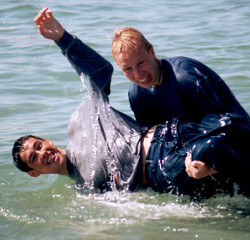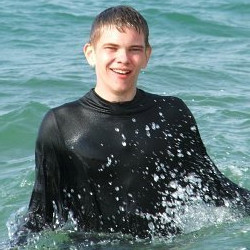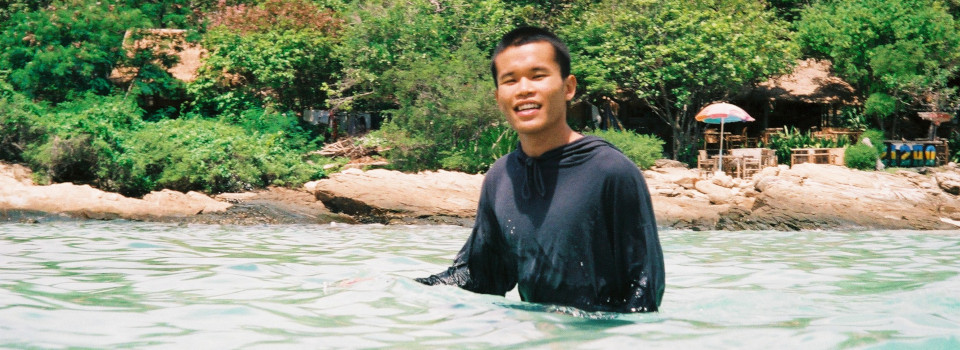Shopping Tips for Sun Protection
Find out all about being safe in the sun, UV protection clothing, and protecting your skin and the environment from toxic sun lotions.
Many people don't realise that sunburn risk on the beach is much higher than inland, due to the light reflection from sand and sea. While we need adequate sunshine to create sufficient amounts of Vitamin D3 for good health, it might be wise to protect our skin from too much sun when on the beach or on boats. Sun protection clothes keep you safe on and in the water.
UV protection sunsuits are among the most comfortable swimwear you can enjoy.
Swim shirts with a tight fit make great swimwear.
You can layer them for warmth or fun fashion.
Sun protection capes with good ventilation are fun for splashing and bathing, not for fast swimming.
UPF Rating for Sun Protection Clothes
UV protection clothes should at least have an UPF 30 rating or above. A garment shouldn't be labelled "sun-protective" or "UV-protective" if its UPF is less than 15.
When swimwear has a UPF 50 rating, the material will only allow 1/50th (2%) of UV (Ultraviolet) radiation get to the skin, helping to protect you from skin cancer and premature skin aging.
Garments with a rating above UPF 50 may be labelled UPF 50+; however, they may not offer substantially more protection than those with a UPF of 50.
Sun-protective clothing may lose its effectiveness if it's too tight or stretched out, and worn and washed repeatedly.
You may see labels on sun-protective garments stating that the garment
meets standards developed by the American Society for Testing and Materials (ASTM),
an organization that has developed a
standard guide for the testing and labelling of UV protective fabrics.
While manufacturers don't have to comply with the ASTM standard guide,
those that say they do must label their garments with UPF values.
Sun Lotion Myth
Of course sun lotion helps, but after the first application, it is difficult to keep it on once you're in the water. Many swimmers find that sunscreen isn't always enough. Some people also have skin allergies or sensitivities to chemicals that sunscreens can contain. In addition, a good sunscreen is rather expensive.
Comfy swimming clothes were created as an alternative to sunscreen and other forms of sun protection. We recommend using a stingersuit or a combination of swim shirts, leggings and sun hats instead of sunscreen which doesn't wash off.
Sunprotection Myth
Contrary to popular belief, a short sleeved swim shirt does not magically protect your whole body from sunburn. It only covers your torso and shoulders and leaves your arms exposed to sunburn when you're out on the beach.
Long sleeve hooded swim shirts with lightweight beach pants are the smart choice because covers all the areas you want to protect from the sun. Add long pants or leggings and you're ready for fun in the water. The darker the swim shirt, the more protection it offers. Best of all, these swim clothes won't wash off and no need to reapply. Because they dry quickly, you can get in and out of the water as you please.
Long T-shirts with jeans are also quite popular for playing on the beach and in the water. These can be great fun when sploshing around in the surf on a hot day. On cooler days add a hoodie or anorak.



These Tips Can Literally Save Your Skin
- Avoid the midday sun when the sun's UV rays are strongest.
- Wear a wide-brimmed hat to protect your eyes, ears, face and the
back of your neck, these areas are prone to overexposure to the sun.
- Wear sunglasses to reduce sun exposure that can lead to cataracts
and other eye damage.
- Wear sun safe swimwear in dark colors with long sleeves and long pants if possible.
A white T-shirt is insufficient as it only has a UPF of about 8 when dry,
a bit more protection if the fabric is dyed or is thicker.
A wet, light-colored shirt transmits nearly as much light to your skin as bare skin!
Wet clothing allows up to 50% more transmission of UV radiation.
If you can see the skin, so can the sun.
Specialist sun protection clothing will keep you safe, doesn't wash off, and feels great. Have a look around this website for more details.
- Use sunscreen on exposed parts before you go out, and reapply every two hours if
you've been perspiring or swimming. Even waterproof sunscreens can
come off when you towel off sweat or water.
Be aware that children under six months of age should never have sunscreen applied to their skin; they can be protected by avoiding time outdoors.
- Pay attention to the UV Index, which provides a forecast of the
expected risk of overexposure to the sun and indicates the degree
of caution you should take when working, playing or exercising outdoors.
The UV Index predicts exposure levels on a scale of 0 to 10+. A 0 indicates a low risk of overexposure; 10+ means a very high risk of overexposure.
- UVA vs. UVB Rays:
UVA's longer-wavelength rays can damage the skin's connective tissue,
leading to premature aging as well as play a role in causing skin cancer.
UVA rays also increase the risk of cataracts and retinal damage and are the type used in tanning salons. UVB radiation has shorter wavelengths and is primarily responsible for sunburn and skin cancer.
Ultraviolet Radiation Exposure depends on:
- How long you're in the sun.
The longer you are out in the sun, the more UV you receive.
- Your clothes.
Most summer clothes often expose more skin to UV and don't provide adequate protection.
A dark hooded garment protects you from UV rays even when wet.
- Your location.
UV is strongest at the equator and gets weaker as you go toward the earth's poles.
- Time of day. UV is greatest at midday when the sun is high (between 10am - 4pm).
- Season: Spring and summer have the highest intensity,
but it is important to use sunscreen year-round.
- Altitude: UV radiation increases 4% per 1000 feet elevation. Therefore,
at 5000 feet (most ski resorts) there is 20% more UV radiation than
at sea level.
- Cloud Cover. Up to 80% of the sun's rays can penetrate puffy, light cloud, mist, haze and fog.
- Reflection: Reflected UV radiation
is as damaging as direct UV radiation:
- Sand/concrete reflects 25% of UV radiation
- Water reflects up to 80% of UV radiation.
- Snow reflects 85% of UV radiation.
- Protection: It is your best bet to reduce your risk of skin cancer and photoaging. Cover up and look good for life.
